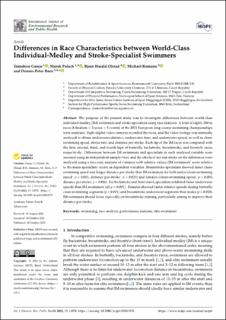Differences in race characteristics between world-class individual-medley and stroke-specialist swimmers
| dc.contributor.author | Gonjo, Tomohiro | |
| dc.contributor.author | Polach, Marek | |
| dc.contributor.author | Olstad, Bjørn Harald | |
| dc.contributor.author | Romann, Michael | |
| dc.contributor.author | Born, Dennis-Peter | |
| dc.date.accessioned | 2023-03-02T12:11:40Z | |
| dc.date.available | 2023-03-02T12:11:40Z | |
| dc.date.created | 2022-11-23T13:53:41Z | |
| dc.date.issued | 2022 | |
| dc.identifier.citation | International Journal of Environmental Research and Public Health. 2022, 19(20), Artikkel 13578. | en_US |
| dc.identifier.issn | 1661-7827 | |
| dc.identifier.uri | https://hdl.handle.net/11250/3055350 | |
| dc.description | This article is an open access article distributed under the terms and conditions of the Creative Commons Attribution (CC BY) license (https://creativecommons.org/licenses/by/4.0/). | en_US |
| dc.description.abstract | The purpose of the present study was to investigate differences between world-class individual medley (IM) swimmers and stroke-specialists using race analyses. A total of eighty 200 m races (8 finalists × 2 sexes × 5 events) at the 2021 European long-course swimming championships were analysed. Eight digital video cameras recorded the races, and the video footage was manually analysed to obtain underwater distance, underwater time, and underwater speed, as well as clean-swimming speed, stroke rate, and distance per stroke. Each lap of the IM races was compared with the first, second, third, and fourth laps of butterfly, backstroke, breaststroke, and freestyle races, respectively. Differences between IM swimmers and specialists in each analysed variable were assessed using an independent-sample t-test, and the effects of sex and stroke on the differences were analysed using a two-way analysis of variance with relative values (IM swimmers’ score relative to the mean specialists’ score) as dependent variables. Breaststroke specialists showed faster clean-swimming speed and longer distance per stroke than IM swimmers for both males (clean-swimming speed: p = 0.011; distance per stroke: p = 0.023) and females (clean-swimming speed: p = 0.003; distance per stroke: p = 0.036). For backstroke and front crawl, specialists exhibited faster underwater speeds than IM swimmers (all p < 0.001). Females showed faster relative speeds during butterfly clean-swimming segments (p < 0.001) and breaststroke underwater segments than males (p = 0.028). IM swimmers should focus especially on breaststroke training, particularly aiming to improve their distance per stroke. | en_US |
| dc.language.iso | eng | en_US |
| dc.subject | elite swimmers | en_US |
| dc.subject | performance analysis | en_US |
| dc.subject | race analysis | en_US |
| dc.subject | swimming | en_US |
| dc.title | Differences in race characteristics between world-class individual-medley and stroke-specialist swimmers | en_US |
| dc.type | Peer reviewed | en_US |
| dc.type | Journal article | en_US |
| dc.description.version | publishedVersion | en_US |
| dc.rights.holder | © 2022 by the authors | en_US |
| dc.source.pagenumber | 10 | en_US |
| dc.source.volume | 19 | en_US |
| dc.source.journal | International Journal of Environmental Research and Public Health | en_US |
| dc.source.issue | 20 | en_US |
| dc.identifier.doi | 10.3390/ijerph192013578 | |
| dc.identifier.cristin | 2079301 | |
| dc.description.localcode | Institutt for fysisk prestasjonsevne / Department of Physical Performance | en_US |
| dc.source.articlenumber | 13578 | en_US |
| cristin.ispublished | true | |
| cristin.fulltext | original | |
| cristin.qualitycode | 1 |
Tilhørende fil(er)
Denne innførselen finnes i følgende samling(er)
-
Artikler / Articles [2096]
-
Publikasjoner fra Cristin [1084]
